Need for Optimum TTM Strategy is Noted as Major Driver of Low-Code Development Platform Market
The key factors driving the growth of the low-code development platform market are the rapid digitization, less requirement for IT
professionals associated with the technology, and regulatory uncertainty. The
market revenue, which was $5.6 billion in 2018, is projected to increase to
$52.3 billion by 2024, at a CAGR of 45.2% during 2019–2024 (forecast period).
With the use of the low-code development platform, developers can combine
several pre-programed application components to create a new app, thus staying
less reliant on IT professionals.
Get the Sample Copy of this Report @ https://www.psmarketresearch.com/market-analysis/low-code-development-platform-market/report-sample
Based on component, the market is bifurcated into
services and solutions, of which solutions held the larger revenue share in 2018.
This was because of the rising adoption of the technology in various sectors,
in order a curb the IT spending. During the forecast period, the services
bifurcation would experience the faster growth, as with the increasing adoption
of the technology, the demand for its implementation and integration in
businesses will also surge.
Additionally, several firms are expected to demand
customization and technical expertise on using it, to create apps. When segmented by enterprise size, the categories of
the low-code development platform market are small and medium enterprises (SME)
and large enterprises. Of these, the market was led by large enterprises during
the historical period (2014–2018), as such organizations have relatively higher
budget for procuring such advanced technology.
Make Enquiry Before Purchase @ https://www.psmarketresearch.com/send-enquiry?enquiry-url=low-code-development-platform-market
The SME category would grow
faster during the forecast period, as several of these would adopt
cost-effective cloud-based solutions, to increase their app development rate
and decrease their operational costs. The fact that this technology significantly lessens
the dependence on IT professionals is the primary reason for the low-code
development platform market growth. Various departments within firm need applications for smooth operations, but the delay in receiving the apps hampers
productivity.
To deal with this, companies hire IT professionals, who leverage
platform as a service (PaaS) and programming languages, such as .NET and Java.
As this incurs heavy expenses, companies are adopting the low-code development
platform, as it allows even non-professionals to create apps. Thus, with the rising smartphone and internet usage,
the demand for cost-effective app creation would continue surging.

Comments
Post a Comment